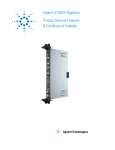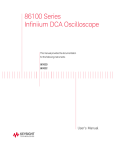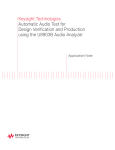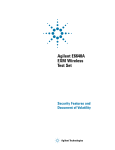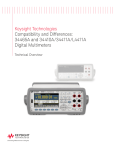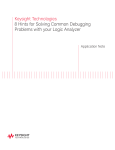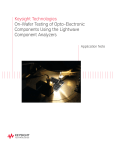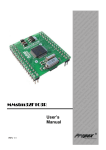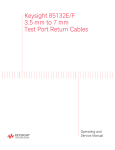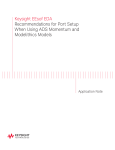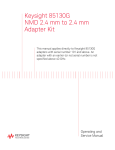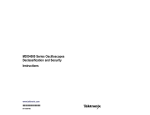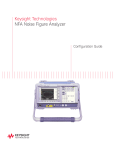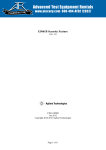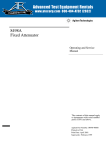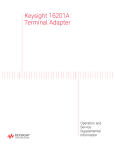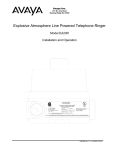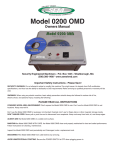Download U8903B Benchtop Audio Analyzer
Transcript
U8903B Benchtop Audio Analyzer This manual provides the documentation for the following instruments: U8903B User’s Manual Notices Manual Part Number Restricted Rights Legend © Keysight Technologies, Inc. 2014-2015 U8903-90056 If software is for use in the performance of a U.S. Government prime contract or subcontract, Software is delivered and licensed as “Commercial computer software” as defined in DFAR 252.227-7014 (June 1995), or as a “commercial item” as defined in FAR 2.101(a) or as “Restricted computer software” as defined in FAR 52.227-19 (June 1987) or any equivalent agency regulation or contract clause. Use, duplication or disclosure of Software is subject to Keysight Technologies’ standard commercial license terms, and non-DOD Departments and Agencies of the U.S. Government will receive no greater than Restricted Rights as defined in FAR 52.227-19(c)(1-2) (June 1987). U.S. Government users will receive no greater than Limited Rights as defined in FAR 52.227-14 (June 1987) or DFAR 252.227-7015 (b)(2) (November 1995), as applicable in any technical data. No part of this manual may be reproduced in any form or by any means (including electronic storage and retrieval or translation into a foreign language) without prior agreement and written consent from Keysight Technologies, Inc. as governed by United States and international copyright laws. Trademark Acknowledgements N/A Print Date September 2015 Supersedes: None Published in USA Keysight Technologies Inc. 1400 Fountaingrove Parkway Santa Rosa, CA 95403 Warranty THE MATERIAL CONTAINED IN THIS DOCUMENT IS PROVIDED “AS IS,” AND IS SUBJECT TO BEING CHANGED, WITHOUT NOTICE, IN FUTURE EDITIONS. FURTHER, TO THE MAXIMUM EXTENT PERMITTED BY APPLICABLE LAW, KEYSIGHT DISCLAIMS ALL WARRANTIES, EITHER EXPRESS OR IMPLIED WITH REGARD TO THIS MANUAL AND ANY INFORMATION CONTAINED HEREIN, INCLUDING BUT NOT LIMITED TO THE IMPLIED WARRANTIES OF MERCHANTABILITY AND FITNESS FOR A PARTICULAR PURPOSE. KEYSIGHT SHALL NOT BE LIABLE FOR ERRORS OR FOR INCIDENTAL OR CONSEQUENTIAL DAMAGES IN CONNECTION WITH THE FURNISHING, USE, OR PERFORMANCE OF THIS DOCUMENT OR ANY INFORMATION CONTAINED HEREIN. SHOULD KEYSIGHT AND THE USER HAVE A SEPARATE WRITTEN AGREEMENT WITH WARRANTY TERMS COVERING THE MATERIAL IN THIS DOCUMENT THAT CONFLICT WITH THESE TERMS, THE WARRANTY TERMS IN THE SEPARATE AGREEMENT WILL CONTROL Technology Licenses The hardware and/or software described in this document are furnished under a license and may be used or copied only in accordance with the terms of such license. 2 Safety Notices A CAUTION notice denotes a hazard. It calls attention to an operating procedure, practice, or the like that, if not correctly performed or adhered to, could result in damage to the product or loss of important data. Do not proceed beyond a CAUTION notice until the indicated conditions are fully understood and met. A WARNING notice denotes a hazard. It calls attention to an operating procedure, practice, or the like that, if not correctly performed or adhered to, could result in personal injury or death. Do not proceed beyond a WARNING notice until the indicated conditions are fully understood and met. Warranty This Keysight technologies instrument product is warranted against defects in material and workmanship. During the warranty period, Keysight Technologies will, at its option, either repair or replace products that prove to be defective. For warranty service or repair, this product must be returned to a service facility designated by Keysight Technologies. Buyer shall prepay shipping charges to Keysight Technologies, and Keysight Technologies shall pay shipping charges to return the product to Buyer. For products returned to Keysight Technologies from another country, Buyer shall pay all shipping charges, duties, and taxes. Where to Find the Latest Information Documentation is updated periodically. For the latest information about these products, including instrument software upgrades, application information, and product information, see the following URLs: http://www.keysight.com/find/U8903B To receive the latest updates by email, subscribe to Keysight Email Updates: http://www.keysight.com/find/MyKeysight Information on preventing instrument damage can be found at: Is your product software up-to-date? Periodically, Keysight releases software updates to fix known defects and incorporate product enhancements. To search for software updates for your product, go to the Keysight Technical Support website at: http://www.keysight.com/find/techsupport 3 Table of Contents 1. Contacting Keysight Sales and Service Offices ............................................................................................... 5 2. Products Covered by this Document ............................................................................................................... 6 3. Security Terms and Definitions ........................................................................................................................ 7 4. Instrument Memory .......................................................................................................................................... 8 5. Summary of Memory Declassification Procedures.......................................................................................... 9 6. User and Remote Interface Security Measures ............................................................................................. 11 7. Procedure for Declassifying a Faulty Instrument .......................................................................................... 12 8. References....................................................................................................................................................... 13 4 Contacting Keysight Sales and Service Offices Assistance with test and measurement needs, and information on finding a local Keysight office, is available on the Internet at: http://www.keysight.com/find/assist If you do not have access to the Internet, please contact your field engineer. In any correspondence or telephone conversation, refer to the instrument by its model number and full serial number. With this information, the Keysight representative can determine whether your unit is still within its warranty period. 5 Products Covered by this Document Product Family Name Product Names Model Numbers Audio Analyzer Benchtop Audio Analyzer U8903B This document describes instrument security features and the steps to declassify an instrument through memory clearing, sanitization or removal. For additional information, go to: http://www.keysight.com/find/security Be sure that all information stored by the user in the instrument that needs to be saved is properly backed up before attempting to clear any of the instrument memory. Keysight Technologies cannot be held responsible for any lost files or data resulting from the clearing of memory. Be sure to read this document entirely before proceeding with any file deletion or memory clearing. 6 Security Terms and Definitions Term Definition Clearing As defined in Section 8-301a of DoD 5220.22-M, clearing is the process of eradicating the data on media before reusing the media so that the data can no longer be retrieved using the standard interfaces on the instrument. Clearing is typically used when the instrument is to remain in an environment with an acceptable level of protection. Instrument Declassification A term that refers to procedures that must be undertaken before an instrument can be removed from a secure environment, such as is the case when the instrument is returned for calibration. Declassification procedures include memory sanitization or memory removal, or both. Keysight declassification procedures are designed to meet the requirements specified in DoD 5220.22-M, Chapter 8. Sanitization As defined in Section 8-301b of DoD 5220.22-M, sanitization is the process of removing or eradicating stored data so that the data cannot be recovered using any known technology. Instrument sanitization is typically required when an instrument is moved from a secure to a nonsecure environment, such as when it is returned to the factory for calibration. Keysight memory sanitization procedures are designed for customers who need to meet the requirements specified by the US Defense Security Service (DSS). These requirements are specified in the “Clearing and Sanitization Matrix” in Section 5.2.5.5.5 of the ISFO Process Manual. Secure Erase Secure Erase is a term that is used to refer to either the clearing or sanitization features of Keysight instruments. 7 Instrument Memory This section contains information on the types of memory available in your instrument. It explains the size of memory, how it is used, its location, volatility, and the sanitization procedure. Writable During Normal Operation? Purpose/ Contents Data Retained When Powered Off? Table 1: Summary of instrument memory Memory Type and Size Data Input Method Location in Instrument and Remarks Sanitization Procedure Processor Flash Memory (P3000) 512MB Yes Yes Storage for purchased options information, application firmware Firmware upgrade, application utility page Processor Card (U8903-66507) Refer to Table 2 Internal Flash (Flash Memory Carrier Board) 4GB Yes Yes Storage for user to store data, filter files backup log files and measurements. Application side menu and SCPI commands Carrier board (U8903-66508) Erasable via Secure Erase, go to System > Service > Secure Erase General Purpose RAM (P3000) 256MB Yes No Storage for temporary data and buffer used by applications. Program code Processor Card (U8903-66507) Cycle power Bluetooth card SDRAM 64MB Yes No Storage of Arbitrary audio waveform. Program code BluetoothCard (U8903-66521) Cycle power Bluetooth card SRAM 18Mbit Yes No Bluetooth Processor’s temporary data storage. Program code BluetoothCard (U8903-66521) Cycle power Bluetooth card DDR2 SDRAM 256MB v No DSP processor’s temporary data storage. Program code BluetoothCard (U8903-66521) Cycle power 8 Memory Type and Size Writable During Normal Operation? Data Retained When Powered Off? Bluetooth card id flash memory 16MB No Yes Purpose/ Contents Data Input Method Location in Instrument and Remarks Sanitization Procedure Store Bluetooth card identification. Factory update BluetoothCard (U8903-66521) Not applicable 9 Summary of Memory Declassification Procedures This section explains how to clear, sanitize, and remove memory from your instrument, for all classes of memory that are writeable during normal operation. Read this entire document before using any sanitization procedure. Failure to do so may necessitate returning the instrument to an Authorized Keysight Service Center for firmware downloads and recalibration. Table 2: Processor Flash Memory Description and purpose Processor Flash Memory used to store application image, calibration constants, serial number and purchased options information. Size 512 MB Memory clearing Application image can be overwritten by user, user can go to system -> Update -> Load File in order to load the firmware file to overwrite. Purchased options can also be added/removed by user, to remove, go to the front panel press System->Service->Options, select the option to be removed from the selection panel and press “Remove Option” menu. Memory sanitization Cleared memory contains no application-specific information. Sanitization is only possible by memory removal. Memory removal This memory cannot be removed without damaging the instrument. Memory validation For firmware overwrite, a message window will pop up to inform if the process is successful/failed. For options removal, verified the menu items relevant to the option are not seen; neither can the SCPI commands be sent. Remarks N/A Table 3: Internal Flash Memory Description and purpose Storage for user to store data, filter files, backup log files and measurements reports. Size 4G Memory clearing To clear the user stored files, ensure current GUI is in standard view, on front panel, press Preset -> To Factory Settings. Alternatively, user can send SCPI commands: SYSTem:PRESet:TYPE FACTory SYSTem:PRESet Memory sanitization To securely erase user stored files, user can go to System -> Service -> Secure Erase. Memory removal The instrument will still operate even the internal flash memory has been removed, however, the user saved data will be erased after cycle power and the instrument will always start up as factory default settings. Memory validation After performing clearing or sanitization procedure, user will not be able to find all the saved user files from the respective folders. Remarks N/A 11 User and Remote Interface Security Measures Local Lockout To prevent unintended attempt to switch the instrument to local mode, user can lock the front panel’s Local key via the following SCPI command: SYSTem:RWLock To unlock, send the following SCPI command: SYSTem:LOCal Screen and Annotation Blanking The instrument’s screen can be set to blank via SCPI command: DISPlay:STATe <On | Off> USB Mass Storage Device Security The instrument is equipped with a USB drive which is writtable so that user can save user states, screen capture and export reports. However, the instrument does not allow direct browsing to the usb contents. Remote Access Interfaces The user is responsible for providing security for the I/O ports for remote access by controlling physical access to the I/O ports. The I/O ports provide access to all user settings, user states and the display image. The I/O ports include USB, GPIB and LAN. The LAN port provides the following services, with limited usages: a) http – limit to LXI web page access. b) ftp – only allow to transfer file from/to instrument’s fixed folder. c) Sockets –SCPI only. d) telnet – SCPI only. e) Ping – to support LXI There is also a ‘ping’ service, which presently cannot be selectively disabled. The concern here might be that it is possible to discover IP addresses of connected instruments in order to query their setups over the net or break into the code. 12 Procedure for Declassifying a Faulty Instrument If the instrument is not functioning and the user is unable to use the security procedures described to declassify the instrument, please contact your local Keysight office for support. http://www.keysight.com/find/contactus 13 References 1. DoD 5220.22-M, “National Industrial Security Program Operating Manual (NISPOM)” United States Department of Defense. Revised February 28, 2006. May be downloaded in Acrobat (PDF) format from: http://www.dss.mil/isp/fac_clear/download_nispom.html 2. ISFO Process Manual for the Certification and Accreditation of Classified Systems under the NISPOM Defense Security Service. DSS-cleared industries may request a copy of this document via email, by following the instructions at: http://www.dss.mil/isp/odaa/request.html














